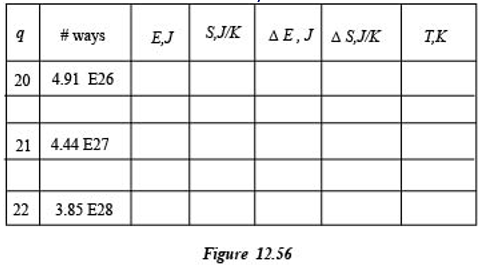The interatomic spring stiffness for tungsten is determined from Young’s modulus measurements to be 90 N. The mass of one mole of tungsten is 0185 kg . If we model a block of tungsten as a collection of atomic “oscillators” (masses on springs), note that since each oscillator is attached to two “springs,” and each “spring” is half the length of the interatomic bond, the effective interatomic spring stiffness for one of these oscillators is 4 times the calculated value given above.Use these precise values for the constants: (Planck’s constant divided by 2π), Avogadro’s number = , (the Boltzmann constant). (a) What is one quantum of energy for one of these atomic oscillators? (b) Figure 12.56 contains the number of ways to arrange a given number of quanta of energy in a particular block of tungsten. Fill in the blanks to complete the table, including calculating the temperature of the block. The energy E is measured from the ground state. Nothing goes in the shaded boxes. Be sure to give the temperature to the nearest 0.1 kelvin. (c) There are about 60 atoms in this object. What is the heat capacity on a per-atom basis? (Note that at high temperatures the heat capacity on a per-atom basis approaches the classical limit of 3kB = 4.2×10−23 J/K/atom.)



